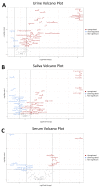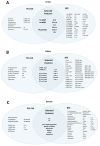Identification of Candidate Salivary, Urinary and Serum Metabolic Biomarkers for High Litter Size Potential in Sows (Sus scrofa)
- PMID: 36355128
- PMCID: PMC9697495
- DOI: 10.3390/metabo12111045
Identification of Candidate Salivary, Urinary and Serum Metabolic Biomarkers for High Litter Size Potential in Sows (Sus scrofa)
Abstract
The selection of sows that are reproductively fit and produce large litters of piglets is imperative for success in the pork industry. Currently, low heritability of reproductive and litter-related traits and unfavourable genetic correlations are slowing the improvement of pig selection efficiency. The integration of biomarkers as a supplement or alternative to the use of genetic markers may permit the optimization and increase of selection protocol efficiency. Metabolite biomarkers are an advantageous class of biomarkers that can facilitate the identification of cellular processes implicated in reproductive condition. Metabolism and metabolic biomarkers have been previously implicated in studies of female mammalian fertility, however a systematic analysis across multiple biofluids in infertile and high reproductive potential phenotypes has not been explored. In the current study, the serum, urinary and salivary metabolomes of infertile (INF) sows and high reproductive potential (HRP) sows with a live litter size ≥ 13 piglets were examined using LC-MS/MS techniques, and a data pipeline was used to highlight possible metabolite reproductive biomarkers discriminating the reproductive groups. The metabolomes of HRP and INF sows were distinct, including significant alterations in amino acid, fatty acid, membrane lipid and steroid hormone metabolism. Carnitines and fatty acid related metabolites were most discriminatory in separating and classifying the HRP and INF sows based on their biofluid metabolome. It appears that urine is a superior biofluid than saliva and serum for potentially predicting the reproductive potential level of a given female pig based on the performance of the resultant biomarker models. This study lays the groundwork for improving gilt and sow selection protocols using metabolomics as a tool for the prediction of reproductive potential.
Keywords: LC-MS/MS; gilt selection; infertility; litter size; metabolomics; reproductive potential; saliva; serum; urine.
Conflict of interest statement
The authors declare no conflict of interest.
Figures






Similar articles
-
Genetic parameters for haemoglobin levels in sows and piglets as well as sow reproductive performance and piglet survival.Animal. 2020 Apr;14(4):688-696. doi: 10.1017/S1751731119002532. Epub 2019 Oct 28. Animal. 2020. PMID: 31657286
-
Sow communication with piglets while being active is a good predictor of maternal skills, piglet survival and litter quality in three different breeds of domestic pigs (Sus scrofa domesticus).PLoS One. 2018 Nov 14;13(11):e0206128. doi: 10.1371/journal.pone.0206128. eCollection 2018. PLoS One. 2018. PMID: 30427860 Free PMC article.
-
Correlates of reproductive tract anatomy and uterine histomorphometrics with fertility in swine.Theriogenology. 2021 Apr 15;165:44-51. doi: 10.1016/j.theriogenology.2021.02.007. Epub 2021 Feb 11. Theriogenology. 2021. PMID: 33611173
-
Animal board invited review: Factors affecting the early growth and development of gilt progeny compared to sow progeny.Animal. 2022 Aug;16(8):100596. doi: 10.1016/j.animal.2022.100596. Epub 2022 Aug 8. Animal. 2022. PMID: 35952479 Review.
-
Review: Nutrient requirements of the modern high-producing lactating sow, with an emphasis on amino acid requirements.Animal. 2019 Dec;13(12):2967-2977. doi: 10.1017/S1751731119001253. Epub 2019 Jun 14. Animal. 2019. PMID: 31199216 Review.
Cited by
-
Metabolomics reveals early pregnancy biomarkers in sows: a non-invasive diagnostic approach.Front Vet Sci. 2024 Apr 25;11:1396492. doi: 10.3389/fvets.2024.1396492. eCollection 2024. Front Vet Sci. 2024. PMID: 38725582 Free PMC article.
-
Effect of SNPs on Litter Size in Swine.Curr Issues Mol Biol. 2024 Jun 24;46(7):6328-6345. doi: 10.3390/cimb46070378. Curr Issues Mol Biol. 2024. PMID: 39057020 Free PMC article.
-
Divergence in the sow vaginal microbiota is associated with fertility.Reproduction. 2025 Jun 18;170(1):e250044. doi: 10.1530/REP-25-0044. Print 2025 Jul 1. Reproduction. 2025. PMID: 40470844 Free PMC article.
-
Genome-Wide Association Analysis Identified Variants Associated with Body Measurement and Reproduction Traits in Shaziling Pigs.Genes (Basel). 2023 Feb 18;14(2):522. doi: 10.3390/genes14020522. Genes (Basel). 2023. PMID: 36833449 Free PMC article.
References
-
- Knol E.F., Nielsen B., Knap P.W. Genomic selection in commercial pig breeding. Anim. Front. 2016;6:15–22. doi: 10.2527/af.2016-0003. - DOI
Grants and funding
LinkOut - more resources
Full Text Sources

